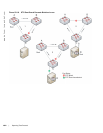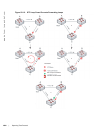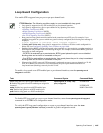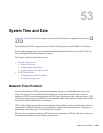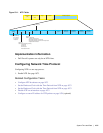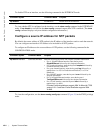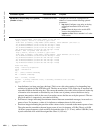1070 | System Time and Date
www.dell.com | support.dell.com
NTP is designed to produce three products: clock offset, roundtrip delay, and dispersion, all of which are
relative to a selected reference clock.
• Clock offset represents the amount to adjust the local clock to bring it into correspondence with the
reference clock.
• Roundtrip delay provides the capability to launch a message to arrive at the reference clock at a
specified time.
• Dispersion represents the maximum error of the local clock relative to the reference clock.
Since most host time servers will synchronize via another peer time server, there are two components in
each of these three products, those determined by the peer relative to the primary reference source of
standard time and those measured by the host relative to the peer.
Each of these components are maintained separately in the protocol in order to facilitate error control and
management of the subnet itself. They provide not only precision measurements of offset and delay, but
also definitive maximum error bounds, so that the user interface can determine not only the time, but the
quality of the time as well.
In what may be the most common client/server model a client sends an NTP message to one or more
servers and processes the replies as received. The server interchanges addresses and ports, overwrites
certain fields in the message, recalculates the checksum and returns the message immediately. Information
included in the NTP message allows the client to determine the server time with respect to local time and
adjust the local clock accordingly. In addition, the message includes information to calculate the expected
timekeeping accuracy and reliability, as well as select the best from possibly several servers.
Following conventions established by the telephone industry [BEL86], the accuracy of each server is
defined by a number called the stratum, with the topmost level (primary servers) assigned as one and each
level downwards (secondary servers) in the hierarchy assigned as one greater than the preceding level.
FTOS synchronizes with a time-serving host to get the correct time. You can set FTOS to poll specific NTP
time-serving hosts for the current time. From those time-serving hosts, the system chooses one NTP host
with which to synchronize and serve as a client to the NTP host. As soon as a host-client relationship is
established, the networking device propagates the time information throughout its local network.
Protocol Overview
NTP message to one or more servers and processes the replies as received. The server interchanges
addresses and ports, fills in or overwrites certain fields in the message, recalculates the checksum and
returns it immediately. Information included in the NTP message allows each client/server peer to
determine the timekeeping characteristics of its other peers, including the expected accuracies of their
clocks. Using this information each peer is able to select the best time from possibly several other clocks,
update the local clock and estimate its accuracy.



